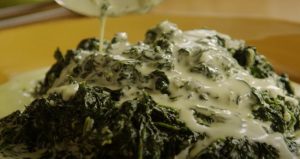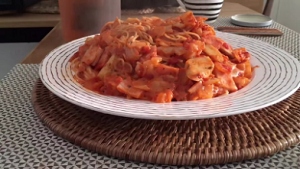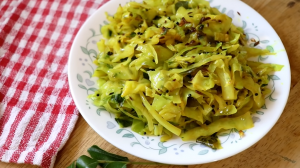Satay, a popular dish in Indonesia, is a simple yet flavorful skewered meat dish typically served with a tangy peanut sauce. This Indonesian Satay recipe is easy to make at home and brings a taste of authentic Indonesian street food right to your kitchen.
The main ingredients for Indonesian Satay are quite common, but there might be a few that are less familiar. The key ingredient is the peanut sauce, which requires chunky peanut butter. If you don't have this at home, you can find it in the peanut butter aisle of your supermarket. Another ingredient you might need to source is cumin, a warm, spicy ground spice used commonly in Middle Eastern and Latin American cuisine. Finally, the recipe calls for peanut oil, which has a higher smoking point and a mild flavor. You can substitute it with vegetable oil if you can't find it.
Ingredients for Indonesian Satay
soy sauce: Used for marinating the chicken and also in the peanut sauce. It adds a salty, umami flavor.
tomato sauce: Helps to tenderize the chicken.
peanut oil: Used for its high smoking point and mild flavor.
garlic cloves: Adds a warm, spicy, aromatic flavor.
ground black pepper: Adds a spicy kick.
ground cumin: Gives a warm, earthy flavor.
chicken breast: The main protein of the dish. It is marinated and then grilled.
vegetable oil: Used for sautéing the onion and garlic for the peanut sauce.
onion: Gives a sweet, savory base flavor to the peanut sauce.
water: Thins out the peanut sauce.
chunky peanut butter: The main ingredient of the peanut sauce. It gives a rich, creamy, nutty flavor.
soy sauce: Adds a salty, umami flavor to the peanut sauce.
white sugar: Balances the savory flavors in the peanut sauce.
lemon juice: Adds a tangy acidity to the peanut sauce.
One reader, Eyde Gagne says:





This Indonesian satay recipe is a game-changer! The marinade is bursting with flavor, and the peanut sauce is the perfect complement. The chicken turns out tender and juicy, and the grilling process is a breeze. It's a hit with my family and friends every time!
Key Techniques for Authentic Indonesian Satay
How to marinate the chicken: Mix the soy sauce, tomato sauce, peanut oil, garlic, black pepper, and cumin in a bowl. Place the chicken into the mixture and stir to coat. Cover and marinate in the refrigerator for at least 15 minutes, but not overnight.
How to make the peanut sauce: Heat the vegetable oil in a saucepan over medium heat, then sauté onion and garlic until lightly browned. Mix in the water, peanut butter, soy sauce, and sugar. Cook and stir until well blended. Remove from heat, then mix in the lemon juice, and set aside.
How to grill the chicken: Preheat the grill to high heat. Lightly oil the grill grate. Thread the chicken onto skewers, then discard the marinade. Grill the chicken for about 5 minutes per side until the chicken juices run clear.
How To Make Indonesian Satay
Grab a bite of this authentic Indonesian satay! It’s made with a savory grilled chicken, served alongside a nutty and sweet sauce, for a filling meal.
Serves:
Ingredients
- 3tbspsoy sauce
- 3tbsptomato sauce
- 1tbsppeanut oil
- 2garlic cloves,peeled, minced
- pinchground black pepper
- pinchground cumin
- 6chicken breast,skinless boneless, halves, cubed
- 1tbspvegetable oil
- ¼cuponion,minced
- 1garlic clove,peeled, minced
- 1cupwater
- ½cupchunky peanut butter
- 2tbspsoy sauce
- 2tbspwhite sugar
- 1tbsplemon juice
Equipments
-
Skewers
Instructions
-
In a bowl, mix the soy sauce, tomato sauce, peanut oil, garlic, black pepper, and cumin. Place chicken into the mixture, then stir to coat.
-
Cover and marinate in the refrigerator for at least 15 minutes, but not overnight.
-
Preheat the grill to high heat.
-
Heat the vegetable oil in a saucepan over medium heat, then sauté onion and garlic until lightly browned.
-
Mix in the water, peanut butter, soy sauce, and sugar. Cook and stir until well blended.
-
Remove from heat, then mix in the lemon juice, and set aside.
-
Lightly oil the grill grate. Thread the chicken onto skewers, then discard marinade.
-
Grill the chicken for about 5 minutes per side until the chicken juices run clear.
-
Serve with the peanut sauce, and enjoy!
Nutrition
- Calories: 503.10kcal
- Fat: 32.00g
- Saturated Fat: 7.42g
- Trans Fat: 0.22g
- Monounsaturated Fat: 15.05g
- Polyunsaturated Fat: 7.30g
- Carbohydrates: 12.10g
- Fiber: 1.72g
- Sugar: 7.12g
- Protein: 42.60g
- Cholesterol: 111.36mg
- Sodium: 885.27mg
- Calcium: 49.82mg
- Potassium: 623.28mg
- Iron: 2.44mg
- Vitamin A: 44.04µg
- Vitamin C: 2.53mg
Crucial Technique Tip for Perfect Satay
To ensure your chicken is juicy and tender, avoid over-marinating. Marinating the chicken for too long can cause the meat to become mushy rather than flavorful. Ideally, 15 minutes to an hour is enough time for the chicken to absorb the flavors of the marinade. Also, when grilling the chicken, make sure to turn the skewers regularly to ensure even cooking and prevent the chicken from burning.
Time-Saving Tips for Making Indonesian Satay Recipe
Prep ahead: Prepare the marinade and peanut sauce the night before and store them in the refrigerator. This will save time on the day of cooking.
Use pre-cut chicken: Consider using pre-cut chicken pieces to save time on preparation.
Grill in batches: If you have a large quantity of chicken, grill them in batches to ensure even cooking and save time.
Invest in skewers: Use metal skewers instead of wooden ones to avoid soaking them in water before grilling, saving time and effort.
Organize ingredients: Before starting, organize all the ingredients and utensils to streamline the cooking process.
Substitute Ingredients For Indonesian Satay Recipe
Soy sauce - Substitute with tamari: Tamari is a gluten-free alternative to soy sauce with a similar flavor profile, making it a suitable substitute for those with dietary restrictions.
Tomato sauce - Substitute with tomato paste: Tomato paste is a concentrated form of tomato sauce, so you can use less of it to achieve a similar flavor and consistency.
Peanut oil - Substitute with vegetable oil: Vegetable oil is a neutral-flavored oil that can be used as a substitute for peanut oil in this recipe.
Garlic cloves - Substitute with garlic powder: Garlic powder can be used as a substitute for fresh garlic cloves, providing a similar flavor without the need for mincing or chopping.
Ground black pepper - Substitute with white pepper: White pepper can be used as a substitute for black pepper, providing a milder flavor and a different appearance in the dish.
Ground cumin - Substitute with ground coriander: Ground coriander can be used as a substitute for ground cumin, providing a similar earthy and citrusy flavor to the dish.
Chicken breast - Substitute with turkey breast: Turkey breast can be used as a lean alternative to chicken breast, providing a similar texture and flavor when prepared in the same manner.
Vegetable oil - Substitute with canola oil: Canola oil is a neutral-flavored oil that can be used as a substitute for vegetable oil in this recipe.
Onion - Substitute with shallot: Shallots can be used as a substitute for onions, providing a milder and sweeter flavor to the dish.
Garlic clove - Substitute with garlic paste: Garlic paste can be used as a substitute for fresh garlic cloves, offering convenience and a similar flavor to the dish.
Water - Substitute with chicken broth: Chicken broth can be used to add flavor and depth to the dish, replacing the water with a richer liquid.
Chunky peanut butter - Substitute with smooth peanut butter: Smooth peanut butter can be used as a substitute for chunky peanut butter, providing a creamy texture to the sauce.
White sugar - Substitute with brown sugar: Brown sugar can be used as a substitute for white sugar, adding a hint of caramel flavor to the dish.
Lemon juice - Substitute with lime juice: Lime juice can be used as a substitute for lemon juice, providing a similar level of acidity and a slightly different citrus flavor to the dish.
Best Way to Present Indonesian Satay
Elevate the plating: Arrange the grilled chicken satay skewers in a symmetrical and visually appealing manner on the plate, ensuring each skewer is positioned with precision and care.
Incorporate vibrant colors: Introduce elements of color to the plate by garnishing with finely chopped cilantro, sliced red chili, and a sprinkle of toasted sesame seeds to add visual interest and depth to the dish.
Focus on texture: Incorporate a contrasting element such as a small side salad of julienned vegetables dressed in a light vinaigrette to provide a textural contrast to the tender and succulent chicken satay.
Utilize negative space: Embrace the concept of negative space on the plate, allowing the vibrant colors and carefully arranged components of the dish to stand out and capture the attention of the diners.
Emphasize precision: Pay close attention to the placement of the accompanying peanut sauce, ensuring it is delicately drizzled around the plate to complement the chicken satay without overwhelming the dish.
Consider the plate shape and size: Select a plate that complements the presentation of the dish, ensuring that it provides ample space for the components while allowing the vibrant colors and textures to shine through.
Add a touch of elegance: Consider incorporating a delicate edible flower or microgreens as a final garnish to add a touch of elegance and sophistication to the overall presentation.
Storing and Freezing Indonesian Satay
- Let the cooked satay cool completely before storing or freezing.
- For short-term storage, place the satay in an airtight container or wrap it tightly with plastic wrap and refrigerate for up to 3-4 days.
- To freeze the satay:
- Place the cooled satay skewers on a baking sheet lined with parchment paper, making sure they are not touching each other.
- Freeze the skewers until solid, about 2-3 hours.
- Once frozen, transfer the skewers to a freezer-safe container or resealable plastic bag, removing as much air as possible to prevent freezer burn.
- Label the container or bag with the date and contents.
- Frozen satay can be stored for up to 2-3 months.
- To reheat frozen satay:
- Preheat your oven to 350°F (175°C).
- Place the frozen skewers on a baking sheet and cover loosely with foil.
- Bake for 15-20 minutes or until heated through.
- Alternatively, you can reheat the satay in a microwave, cooking for 1-2 minutes on high power or until heated through.
- For the peanut sauce, store it in an airtight container in the refrigerator for up to 5 days.
- To freeze the peanut sauce, pour it into a freezer-safe container or ice cube tray, leaving some space at the top for expansion.
- Thaw frozen peanut sauce in the refrigerator overnight before reheating in a saucepan over low heat, stirring occasionally.
How To Reheat Leftover Satay
To reheat leftover Indonesian satay, start by preheating your oven to 350°F (175°C). Place the satay skewers on a baking sheet lined with parchment paper or aluminum foil. Brush the satay with a little bit of vegetable oil to help prevent them from drying out during the reheating process. Bake the satay in the preheated oven for about 10-15 minutes, or until they are heated through and the edges start to crisp up slightly.
Another option is to reheat the satay in a skillet on the stovetop. Heat a tablespoon of vegetable oil in a large skillet over medium heat. Once the oil is hot, add the satay skewers and cook them for 2-3 minutes on each side, or until they are heated through and slightly crispy on the outside. Be sure to watch them closely to avoid burning.
If you have leftover peanut sauce, you can reheat it in a small saucepan over low heat, stirring occasionally. If the sauce seems too thick, you can thin it out with a little bit of water or coconut milk. Once the sauce is heated through, remove it from the heat and serve it alongside the reheated satay.
For a quick and easy reheating method, you can also use the microwave. Place the satay skewers on a microwave-safe plate and heat them on high power for 1-2 minutes, or until they are heated through. Be sure to check them every 30 seconds to avoid overheating and drying them out.
If you want to add some extra flavor and moisture to your leftover satay, try brushing them with a mixture of soy sauce, honey, and a little bit of sesame oil before reheating them in the oven or on the stovetop. This will help to caramelize the exterior of the satay and give them a delicious glaze.
Interesting Fact About Indonesian Satay
Indonesian satay is a popular street food in Indonesia and is often served with rice cakes and peanut sauce. It is a flavorful and aromatic dish that is enjoyed by many people around the world.
Is Making Indonesian Satay at Home Cost-Effective?
This Indonesian Satay recipe is quite cost-effective for a household. The key ingredients like chicken breast, peanut butter, and soy sauce are affordable and readily available. The dish offers a delightful blend of flavors and textures, making it a satisfying meal for the entire family. The approximate cost for a household of 4 people is around $15-$20, making it a budget-friendly option. Overall, I would rate this recipe an 8 out of 10 for its affordability, delicious taste, and ease of preparation.
Is Indonesian Satay Healthy or Unhealthy?
The Indonesian satay recipe, while flavorful, may not be the healthiest option due to a few key ingredients:
- The marinade and sauce contain a significant amount of soy sauce, which is high in sodium
- The peanut sauce is made with chunky peanut butter, which can be high in fat and calories
- The recipe calls for white sugar, adding empty calories to the dish
However, the recipe does include some healthy elements, such as lean chicken breast and the use of vegetable oil for sautéing.
To make this recipe healthier, consider the following modifications:
- Use low-sodium soy sauce or replace some of the soy sauce with coconut aminos to reduce the sodium content
- Opt for natural, unsweetened peanut butter to reduce added sugars and unhealthy fats
- Replace the white sugar with a natural sweetener like honey or coconut sugar, or reduce the amount used
- Increase the amount of vegetables in the dish by adding bell peppers, onions, or zucchini to the skewers
- Serve the satay with a side of brown rice or quinoa instead of white rice to increase the fiber content
By making these adjustments, you can enjoy the delicious flavors of Indonesian satay while making it a more well-rounded and nutritious meal. Remember, moderation is key, and enjoying this dish as part of a balanced diet can still be part of a healthy lifestyle.
Editor's Opinion on This Indonesian Satay Recipe
The Indonesian satay recipe you've provided is a delightful blend of flavors and textures. The marinade infuses the chicken with a rich umami taste, while the peanut sauce adds a creamy and slightly sweet contrast. The grilling process ensures a succulent and smoky finish to the chicken skewers. However, I would suggest adjusting the marinating time to at least 30 minutes for a more intense flavor. Additionally, consider adding a touch of lime zest to the peanut sauce for a refreshing citrus note. Overall, this recipe promises a satisfying and aromatic dining experience.
Enhance Your Indonesian Satay Recipe with These Unique Side Dishes:
Similar Recipes to Indonesian Satay
Perfect Appetizers and Desserts for Indonesian Satay
Why trust this Indonesian Satay Recipe:
This recipe is a trusted classic, using traditional Indonesian flavors and techniques. The marinade infuses the chicken breast with rich, savory soy sauce and aromatic garlic, while the peanut sauce adds a creamy, nutty balance with chunky peanut butter and a hint of tangy lemon juice. The combination of grilling and the homemade peanut sauce creates an authentic and delicious satay experience that will transport you to the vibrant streets of Indonesia. Trust the expertise behind this recipe for an unforgettable culinary journey.
Was this page helpful?
Have your own special recipe to share? Submit Your Recipe Today!














